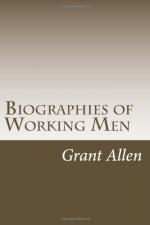Meanwhile, George, like most other young men, had fallen in love. His sweetheart, Fanny Henderson, was servant at the small farmhouse where he had taken lodgings since leaving his father’s home; and though but little is known about her (for she unhappily died before George had begun to rise to fame and fortune), what little we do know seems to show that she was in every respect a fitting wife for the active young brakesman, and a fitting mother for his equally celebrated son, Robert Stephenson. Fired by the honourable desire to marry Fanny, with a proper regard for prudence, George set himself to work to learn cobbling in his spare moments; and so successfully did he cobble the worn shoes of his fellow-colliers after working hours, that before long he contrived to save a whole guinea out of his humble earnings. That guinea was the first step towards an enormous fortune; a fortune, too, all accumulated by steady toil and constant useful labour for the ultimate benefit of his fellow-men. To make a fortune is the smallest and least noble of all possible personal ambitions; but to save the first guinea which leads us on at last to independence and modest comfort is indeed an important turning-point in every prudent man’s career. Geordie Stephenson was so justly proud of his achievement in this respect that he told a friend in confidence he might now consider himself a rich man.
By the time George was twenty-one, he had saved up enough by constant care to feel that he might safely embark on the sea of housekeeping. He was able to take a small cottage lodging for himself and Fanny, at Willington Quay, near his work at the moment, and to furnish it with the simple comfort which was all that their existing needs demanded. He married Fanny on the 28th of November, 1802; and the young couple proceeded at once to their new home. Here George laboured harder than ever, as became the head of a family. He was no more ashamed of odd jobs than he had been of learning the alphabet. He worked overtime at emptying ballast from ships; he continued to cobble, to cut lasts, and even to try his hand at regular shoemaking; furthermore, he actually acquired the art of mending clocks, a matter which lay strictly in his own line, and he thus earned a tidy penny at odd hours by doctoring all the rusty or wheezy old timepieces of all his neighbours. Nor did he neglect his mechanical education meanwhile for he was always at work upon various devices for inventing a perpetual motion machine. Now, perpetual motion is the most foolish will-o’-the-wisp that ever engaged a sane man’s attention: the thing has been proved to be impossible from every conceivable point of view, and the attempt to achieve it, if pursued to the last point, can only end in disappointment if not in ruin. Still, for all that, the work George Stephenson spent upon this unpractical object did really help to give him an insight into mechanical science which proved very useful to him at a later date. He didn’t discover perpetual motion, but he did invent at last the real means for making the locomotive engine a practical power in the matter of travelling.




